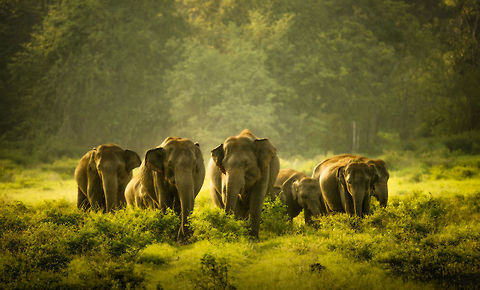
Appearance
In general, Asian elephants are smaller than African elephants and have the highest body point on the head. The tip of their trunk has one finger-like process. Their back is convex or level. Females are usually smaller than males, and have short or no tusks.Sri Lankan elephants are the largest subspecies reaching a shoulder height of between 2 and 3.5 m, weigh between 2,000 and 5,500 kg, and have 19 pairs of ribs. Their skin color is darker than of "indicus" and of "sumatranus" with larger and more distinct patches of depigmentation on ears, face, trunk and belly.
Only 7% of males bear tusks.
According to the elephant census conducted in 2011 by the Wildlife Conservation Department of Sri Lanka, only 2% of the total population are tuskers.
Sri Lankan elephants are somewhat diminutive when compared with historical accounts dating back to 200 BC and with photographs taken in the 19th century during the time of colonial British rule of the island. The smaller size could possibly be the end result of a long-continued process of removing the physically best specimens from the potential breeding-stock through hunting or domestication.
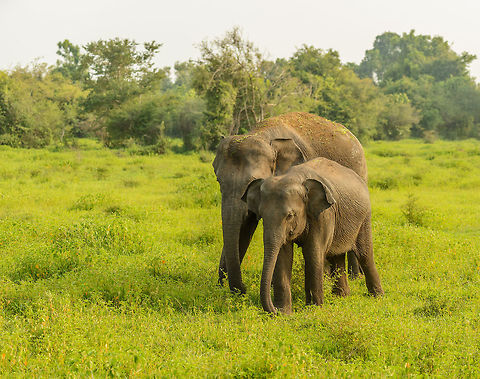
Distribution
Elephants are restricted mostly to the lowlands in the dry zone where they are still fairly widespread in north, south, east, north-western, north-central and south-eastern Sri Lanka. A small remnant population exists in the Peak Wilderness Sanctuary. They are absent from the wet zone of the country. Apart from Wilpattu and Ruhuna National Parks, all other protected areas are less than 1,000 km2 in extent. Many areas are less than 50 km2, and hence not large enough to encompass the entire home ranges of elephants that use them. In the Mahaweli Development Area, protected areas such as Wasgomuwa National Park, Flood Plains National Park, Somawathiya National Park, and Trikonamadu Nature Reserve have been linked resulting in an overall area of 1,172 km2 of contiguous habitat for elephants. Nevertheless, about 65% of the elephants range extends outside protected areas.The size of wild elephant populations in Sri Lanka was estimated at⤷ 12,000 to 14,000 in the early 19th century;
⤷ 10,000 in the early 20th century;
⤷ 7,000 to 8,000 in around 1920;
⤷ between 1,745 and 2,455 individuals in 1969;
⤷ between 2,500 and 3,435 in 1987;
⤷ 1,967 in June 1993 that were fragmented in five regions;
⤷ between 3,150 and 4,400 in 2000;
⤷ 3,150 in 2006;
⤷ 2,900-3,000 in 2007;
⤷ 5,879 in 2011, on the basis of counting elephants at water holes in the dry season.

Status
"Elephas maximus" is listed on CITES Appendix I.The elephant conservation strategy of the Department of Wildlife Conservation aims at conserving as many viable populations as possible in as wide a range of suitable habitats as is feasible. This means protecting elephants both within the system of protected areas and as many animals outside these areas that the land can support and landholders will accept, and not restricting elephants to the protected area network alone.
⤷ In the Pinnawala Elephant Orphanage in Kegalle injured elephants are treated, and orphaned baby elephants cared for. Nearly 70 elephants live here. Captive breeding is also going on.
⤷ The Udawalawe Elephant Transit Centre in Udawalawe National Park is a rehabilitation centre, where orphaned elephant calves are being kept until they can be released into the wild.
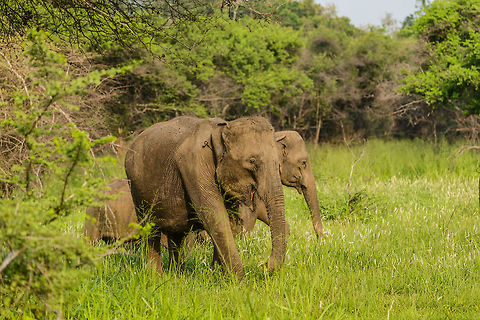
Behavior
Elephants are classified as megaherbivores and consume up to 150 kg of plant matter per day. As generalists they feed on a wide variety of food plants. In Sri Lanka's northwestern region, feeding behaviour of elephants was observed during the period of January 1998 to December 1999. The elephants fed on a total of 116 plant species belonging to 35 families including 27 species of cultivated plants. More than half of the plants were non tree species, i.e. shrub, herb, grass, or climbers. More than 25% of the plant species belonged to the family "Leguminosae", and 19% of the plant species belonged to the family of true grasses. The presence of cultivated plants in dung does not result solely due to raiding of crops as it was observed that elephants feed on leftover crop plants in fallow chenas. Juvenile elephants tend to feed predominantly on grass species.Food resources are abundant in regenerating forests, but at low density in mature forests. Traditional slash-and-burn agriculture creates optimum habitat for elephants through promoting successional vegetation.
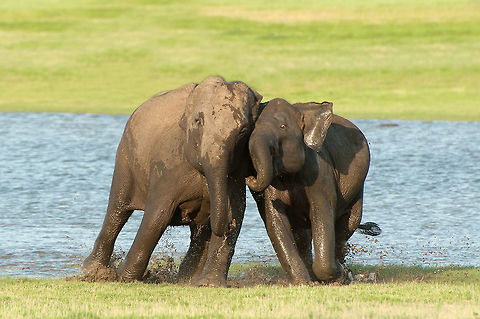
Habitat
Elephants are restricted mostly to the lowlands in the dry zone where they are still fairly widespread in north, south, east, north-western, north-central and south-eastern Sri Lanka. A small remnant population exists in the Peak Wilderness Sanctuary. They are absent from the wet zone of the country. Apart from Wilpattu and Ruhuna National Parks, all other protected areas are less than 1,000 km2 in extent. Many areas are less than 50 km2, and hence not large enough to encompass the entire home ranges of elephants that use them. In the Mahaweli Development Area, protected areas such as Wasgomuwa National Park, Flood Plains National Park, Somawathiya National Park, and Trikonamadu Nature Reserve have been linked resulting in an overall area of 1,172 km2 of contiguous habitat for elephants. Nevertheless, about 65% of the elephants range extends outside protected areas.Elephants are classified as megaherbivores and consume up to 150 kg of plant matter per day. As generalists they feed on a wide variety of food plants. In Sri Lanka's northwestern region, feeding behaviour of elephants was observed during the period of January 1998 to December 1999. The elephants fed on a total of 116 plant species belonging to 35 families including 27 species of cultivated plants. More than half of the plants were non tree species, i.e. shrub, herb, grass, or climbers. More than 25% of the plant species belonged to the family "Leguminosae", and 19% of the plant species belonged to the family of true grasses. The presence of cultivated plants in dung does not result solely due to raiding of crops as it was observed that elephants feed on leftover crop plants in fallow chenas. Juvenile elephants tend to feed predominantly on grass species.Food resources are abundant in regenerating forests, but at low density in mature forests. Traditional slash-and-burn agriculture creates optimum habitat for elephants through promoting successional vegetation.

Predators
During the armed conflict in Sri Lanka, elephants were maimed or killed by land mines. Between 1990 and 1994, a total of 261 wild elephants died either as a result of gunshot injuries, or were killed by poachers and land mines. Several elephants stepped on land mines and were crippled.Today, given the rarity of tuskers in Sri Lanka, poaching for ivory is not a major threat. Nevertheless, some trade in ivory still goes on. Kandy has been identified as the centre for such illegal trade. The greatest threat to elephants comes from an expanding human population and its demand for land. Loss of significant extents of elephant range to development continues currently, with a number of irrigation and development projects leading to the conversion of more elephant ranges to irrigated agriculture and settlements.
Between 1999 to the end of 2006 every year nearly 100 wild elephants were killed. Elephants are killed to protect crops and houses. Other threats are poaching, deforestation, drought and starvation. During drought seasons many elephants damage agricultural land for food. Nearly 80 elephants were killed in north western Sri Lanka, 50 in south and east, and another 30 in other parts of the country, totaling 160 elephant deaths in 2006 alone.
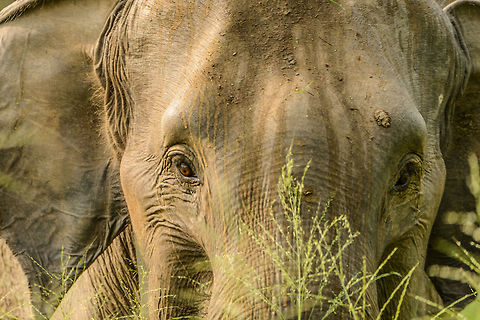
Cultural
Elephants were a common element in Sinhalese heraldry for over two thousand years and remained so through British colonial rule. The coat of arms and the flag of Ceylon Government from 1875 to 1948 included an elephant and even today many institutions use the Sri Lankan elephant in their coat of arms and insignia.An important cultural symbiosis has continued to exist between the elephant and humans for over two thousand years – no religious procession was complete without its retinue of elephants, and many large Buddhist temples in Sri Lanka had their own elephants.
References:
Some text fragments are auto parsed from Wikipedia.